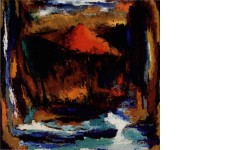Pintura al óleo 5Grabado 1
Información para el artista
TÍTULOUMBRELLAS ΑΤ THE BEACH
MEDIDAS Altura : 85
Ancho : 90
MATERIALES UTILIZADOSPintura al óleo (óleo sobre táblex o aglomerado)
FIRMAAbajo a la derecha
AÑO01-01-1959
CONTROL DE AUTENTICIDADno seleccionado

Painted in 1959.
Literature:
Stelios Lydakis, Coula Bekiari Paintings Engravings, Melissa publications, p.39 (illustrated)
Greek Contemporary Art, Painters, Sculptors, Engravers, Cultural Center Ora, p.135 (illustrated)
Angelos Prokopiou, History of Art 1750-1950, Athens 1968-69, p.p.329, 306 (fig.XLVI illustrated)
An important painting, highly praised by art historians and critics, Umbrellas at the beach marks a transition in the artists career, boldly differentiating her work from the misty atmosphere of her earlier period, which was highly influenced by the style of her teacher Th. Triantafyllidis (see lot 116 and compare Advices auctioned by Bonhams, Greek Sale 13/12/2005, lot 124). Umbrellas clearly shows the extent to which the basic stylistic attributes of Triantafyllidis art flourished and were transcended, both in terms of composition and evolution of a figurative subject into an abstract field of shapes.1
In his book Coula Bekiari, Professor S. Lydakis made the following comment: Umbrellas at the beach, clearly reveals Bekiaris expressive reorientation. Its no longer the spiritualistic light, once used to create the sfumato of an ungraspable world, which gives shape to this image. Here it is colour above all that dominates both as a symbol and an end in itself. The term expressionistic impressionism is perfectly suited for the style encountered in this case. Though the term seems to entail a contradiction, here the chromatic reflections are blended in an impressionistic manner, while the highly charged colour scheme is clearly expressionistic in character.2
In Umbrellas, the three basic colours used by Bekiari -red, ochre and blue- occupy three distinct realms that support each other not by blended effects but through stark juxtapositions. Her palette is enriched with green, mauve, orange and white, while a fauvist atmosphere transforms the landscape into a primitive land of Gauguinesque miracles.3 This painting recalls certain watercolours by E. Nolde, who used extensive, uniform planes, one next to the other, without colour gradations. No horizon is visible. It is suggested instead, in the distant background, as a metaphor for hope. The main subject is this feast of colour offered by these umbrellas. In the foreground, flanking them, beautiful shadows look like receding tree-lines. A small patch of sea, in the extreme foreground, alludes to the beach.4
1. A. Kotidis, Theofrastos Triantafyllidis [in Greek], Thessaloniki, 2002, pp. 318-319
2. S. Lydakis, Koula Bekiari, Painting / Sculpture [in Greek], Melissa, Athens 1976, p. 31
3. A. Prokopiou, History of Art 1750-1950 [in Greek], Athens, 1968-1969, p. 329
4. Y. Miliadis, lecture at the Athens Technological Institute, 1964, as quoted in Lydakis, p. 39